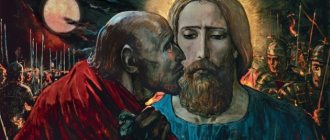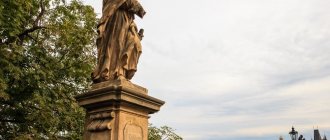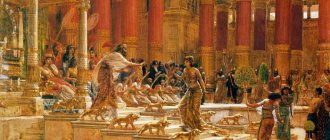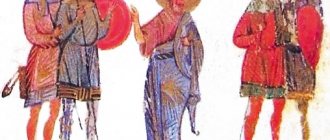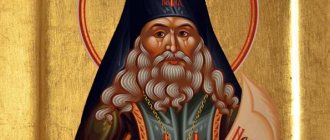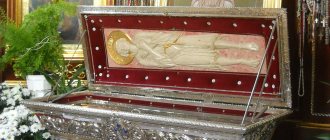Was the betrayal of Judas a necessary link in the work of the Redemption of man?
Nowadays, we often have to deal with prejudice regarding the role of Judas in Divine Providence. According to a number of thinkers, if he had not betrayed the Savior, He would not have been captured and crucified, which means there would have been no Redemptive Sacrifice on the Cross, there would have been no forgiveness of sins and salvation. In a more cautious version, this philosophical idea is replaced by another: if Judas refused to betray, his role would certainly have to be filled by someone else, for this was God’s plan of Redemption.
In line with such concepts, the moral assessment of Judas varies.
According to one version, he was not motivated by a thirst for profit (thirty pieces of silver is the price of a slave), but by the desire for the speedy manifestation of the Divine glory of Christ. Within the framework of this judgment, Judas allegedly believed that when the Lord becomes the prey of his enemies, then he will certainly manifest and publicly reveal the hidden power of His Divinity, which will cause universal recognition of His Divinity, obedience, and salvation.
An even more original statement says that Judas, having sold Christ, did not actually betray Him, but performed a feat of humility and self-abasement, as if he, having fulfilled the task of the traitor, carried out the Lord’s order, which served to realize God’s plan, which included taking Christ into custody, interrogation, the Suffering of the Cross, death. Therefore, being scolded for betrayal, he will be scolded undeservedly. Therefore, the commentary on this story should be rewritten, because in the sight of God, Judas is a great saint.
What can you say to this? The opinion that Judas Iscariot is not a traitor is bad. Following this free interpretation, it is easy to come to the conclusion that some merit in the matter of Salvation also belongs to the murderers of Christ. After all, it is possible (but not necessary) to say about them: if it were not for the murderers, there would have been no Death on the Cross, there would have been no victory over hell and the Resurrection.
But this is not so. And the point here is this. Unlike people, the details of the earthly ministry of the Son of God were known to Him even before the creation of the world. He knew from eternity that many Jews, due to hardness of heart and recklessness, would not accept His Gospel, and from eternity He knew that one of His disciples, flattered by profit, would not persist in piety. If the events of those times, for some reason, were destined to develop differently, this would affect individual details of the plan of Salvation, but not the plan as a whole. The rescue would still have taken place.
The villainy of Judas is directly captured by the words of the Gospel, testifying that he committed the betrayal not out of spiritual simplicity and, especially, not out of the secret blessing of God, but consciously, according to the inspiration of Satan (Luke 22:3). In addition, the Savior personally called him the devil (while the instigators of His murder were called “only” the children of Satan in John 8:44, John 6:70).
***
Archpriest Dimitry Yurevich, Head of the Department of Biblical Studies of the St. Petersburg Theological Academy
Slavs
JUDAS, Ida - according to New Testament tradition, one of the apostles who betrayed Jesus Christ. In the Slavic folk tradition, I. is a character in legends, mythological stories and ritual mummers. According to folk legends, the reason for I.'s crime lies in his past: I. was conceived on a fast day (Friday), therefore he must become a villain and a murderer; I.'s mother was pregnant for a whole year; I.'s fate is decided before his birth in a dispute between two angels, and in the second half of I.'s life goes to the evil angel; I. was born red-haired, which confirmed his evil disposition (cf. Ukrainian and Russian ideas about red hair, squint, and burr as “inhuman” signs). Parents throw I. in a barrel into the sea, because... dream that their son will kill his father and marry his mother; many years later, I. actually commits murder and incest; his mother recognizes him by his mark: a scar on his stomach or thigh, a gold pin in his head (see Incest). After repentance (for 33 years he carried water to the top of the mountain and watered a dry stick until it blossomed) I. was accepted as one of Christ’s disciples. Sometimes I. acts as a “double” of Christ, completely repeating his fate: I. and Jesus were born in the same village, grew up together, were friends; I. betrayed Christ, but he himself was crucified on the cross. I.'s betrayal is driven by greed, envy, a sense of rivalry, and even ethnic difference (according to the Polesie legend, Judas was a Jew, and Christ was Russian). Having committed betrayal, I. committed suicide in order to get ahead of Christ, to quickly go to hell, to be saved along with other people and to keep his pieces of silver, but he was late and remained in hell forever. According to Slavic legends, I. hanged himself on an aspen, which is why it trembles all the time and tastes bitter, on elderberry, on rowan, on oak; I wanted to hang myself on a birch tree that turned white from fear; I.’s blood fell on the alder, and the wood acquired a reddish color; was crushed by a tree, released his entrails, was broken in the fall, his body decomposed from an unknown disease. Tobacco, horseradish, onions, and garlic grew from I.’s body. After death, I. went to hell, where he sits on Satan’s lap as the greatest sinner. According to Ukrainian belief, the soul of I. can wander the earth and inhabit a person who breaks the fast during Holy Week, causing epilepsy. Associated with the name I. is the idea that after his death, hanged people, drowned people and suicides appeared among people. The Slavs bring I. closer to various demonological characters, cf. Ukrainian Yuda - “evil spirit, evil spirit.” The southern Slavs have beliefs about “Yudas” - evil demons who strangle children at night and harm people (Bulgaria, Macedonia). In Belarusian fairy tales, “Yuda the lawless devil” is a humanoid forest creature, a werewolf with deadly fangs. In the stories of the Siberians, “Judas the Lawless” becomes close to the merman: if you refuse I.’s request, he will be dragged into the pond, under the mill wheel. Western and southern Slavic Catholics have rituals of “burning” and “expulsion” dedicated to Holy Week. A straw or wooden effigy, called “Judas,” was carried through the streets, beaten, pulled by the hair, hung in the square, in the cemetery, drowned in river, thrown from the church tower, broken and burned near the church. The firebrands from this fire were credited with the magical power to protect the household from evil spirits; they were used to make “Judas crosses”, which were stuck in the field as a talisman against hail, rain, witches, or on St. Jan (24.VI) was buried in manure in the yard so that the witch would not enter the stable. In the Czech Republic and Slovakia "I." participated in the pre-Easter processions of mummers. The painted wooden (rag, straw) figure of I. was driven around the village in a wheelbarrow, singing songs about I.’s betrayal, the torment and death of Christ. Among the Western Slavs, Easter ritual cookies in the form of human figures and loops called “Judas loops” are widespread. These cookies were smeared with honey so that during the year a person would not be bitten by snakes and would not be lured into the swamp by swamp lights. Ideas about I. are also associated with “evil days”: among Lusatians and Poles, April 1 is considered an unlucky day - on this day I. was allegedly born. Lit.: Soloviev S.V. To the legends about Judas the traitor. Kharkov, 1895. O.V. Belova < SMES
What was Judas' role in all this? Without him it was impossible to make an arrest?
The role was key. Judas’ betrayal was not limited to the fact that on Wednesday he came to the high priests, reported some information and received thirty pieces of silver for it. No, for this money more was required of him: he had to lead the entire “special operation”. That is, firstly, to bring the temple guards and Roman soldiers to the right place at the right time, and secondly, to show who exactly should be arrested, which of those gathered on the Mount of Olives is Jesus. For the Roman soldiers, all these Jews were alike; they had to give a sign who to grab. Thirdly, Judas should have “settled” problems if they suddenly arose.
And problems did arise. From the Gospel of John the Theologian we know an important detail that other evangelists do not have. When this armed crowd approaches, Christ, knowing the intentions of their hearts, asks: “Whom are you looking for?” They answer: “Jesus of Nazareth.” He replies: “It’s me!” And then everyone falls on their faces. Everyone, including Roman soldiers.
Why are they falling? There is a version that the words of Jesus, translated as “I am” in the Greek translation, sounded like the name of God in Hebrew. That is, “Yahweh.” This name in that era should no longer be pronounced out loud, and when they heard it, the Jews fell on their faces in fear. But why then did the Romans fall, for whom all this meant nothing? Commenting on this place, St. John Chrysostom suggests that at the moment when the Lord revealed himself, something happened, somehow He revealed His power. Even the Roman soldiers were affected, confusion and confusion arose. And then Judas, in order to stop possible panic, decisively intervenes and comes to the fore. He greets Jesus - both to show the soldiers who to grab, and to reassure them: they say, everything is in order, everything is under control, this is an ordinary person, since I greet him in such a friendly way.
Giotto's innovations. Composition. Volume.
Now let's take another look at Giotto's fresco. To fully appreciate all his innovations.
Giotto. Kiss of Judas. 1303-1305 Fresco in the Scrovegni Chapel in Padua, Italy
Giotto creates a thoughtful composition. The compositional center coincides with the center of the picture. These are the heads of Christ and Judas. Giotto highlights the center with the raised hand of the priest and the hand with the knife of St. Peter. If you mentally draw lines from their hands, then they will just converge on the heads of the main characters.
Before Giotto, composition was not even thought about. The main characters were placed in the middle. They were distinguished by their large size or hovering above everyone else. Minor characters were depicted smaller or shorter.
Look how voluminous Giotto's figures are. The master boldly uses the technique of chiaroscuro. Of course, his figures are heavy and heavy. After all, at that time painters did not study human anatomy. But the draping of clothes is much more natural.
Why was there a kiss? Wasn't it enough to just point a finger?
At that time in Judea this was a common greeting between friends. And by resorting to this form of address, Judas thereby shows his special closeness to the Teacher (perhaps thereby overcoming his own embarrassment and timidity) - and at the same time gives the soldiers a sign who to grab. But not only that: he thereby seems to emphasize that this is not God, before whom they just prostrated themselves, but an ordinary person with whom he, the leader of the capture group, greets them familiarly. This is the sophistication of Judas, who wants to emphasize his closeness to the one whom he betrays.
By the way, this cynicism of his is indicated by the Lord Himself with the words: Do you betray the Son of Man with a kiss? (Luke 22:48).
Orthodox magazine “Thomas”
***
Giotto and Cimabue
Let's compare Giotto's fresco with the work of his teacher Cimabue. He also made timid attempts to move away from iconographic canons. But in this the student clearly surpassed the teacher.
Cimabue. Kiss of Judas. 1277-1280 Fresco in the Church of San Francesco, Assisi, Italy
In Cimabue we already see the blue of the sky and elements of the landscape instead of an abstract golden background. The faces of those depicted are already more or less different from each other.
But still Cimabue is far from Giotto. His fresco does not contain Giotto's most important innovations. Emotions. And volume. And that means realism.
His figures are flat. Judas seems glued to Jesus. And he can’t even reach the ground with his feet. The face of Christ expresses nothing. The figures of St. Peter with a slave in the left corner of the fresco are very small compared to the other characters.
What events related to Judas Iscariot are described in the Gospel?
The Gospels reflect a uniform sequence of events in general in connection with which Judas Iscariot is mentioned: 1) calling as an apostle (his name is mentioned in the list of apostles); 2) Judas’ intention to betray Jesus and the announcement of this intention to the high priests; 3) Last Supper: Jesus' prediction that He would be betrayed; a short dialogue between Jesus and Judas Iscariot, exposing his intentions, the departure of Judas Iscariot to commit betrayal; 4) scene in the Garden of Gethsemane: Judas Iscariot comes with an armed detachment to the meeting place of the disciples and betrays Jesus with a hypocritical greeting and kiss; 5) Judas Iscariot’s repentance for what he had done and his suicide (only in the Evangelist Matthew).
Saint Peter and the slave with the cut off ear
Now look at the figures of St. Peter and the slave. And remember how Giotto’s predecessors portrayed them.
Giotto. Kiss of Judas. 1303-1305 Fresco in the Scrovegni Chapel in Padua, Italy
Their figures are normal sizes. They are harmoniously integrated into the composition. We believe that St. Peter is trying to rush to the defense of Christ. He pulled out a knife to stab Judas. But he cut off the ear of the person who came under his arm. It is no longer just stuck somewhere on the side. He's in the crowd. He is angry.
What is the difference between Peter's repentance and Judas' repentance?
Analysis of the background of the sin of Judas and the sin of Peter ultimately leads to a contrast between these gospel characters, one of whom repented, but did not repent in the gospel sense of “change of mind” (“metanoia”) and, continuing to remain in sinful darkness, despaired and hanged himself , and the other wept bitterly (Matthew 26:75) and, filled with love for Christ, resorted to His mercy, repented, was forgiven, received the Lord's blessing, became the supreme apostle and testified his fidelity to the Lord by martyrdom. This suggests, first of all, that there is a cardinal metaphysical difference between the repentance of Judas and the repentance of Peter. Repentance turns out to be only the torment of a bad conscience, which does not seek or expect, however, forgiveness, which does not believe in the One who has the power to forgive sins, who took upon himself the sin of the world (John 1:29). Repentance, thus, can overtake an unbeliever, but repentance occurs exclusively before the face of the Lord, on the eve of the approaching Kingdom of Heaven. Repent; for the Kingdom of Heaven is at hand (Matthew 4:17) - with these words the Lord goes out to preach after His temptation by Satan in the desert.
Full face and profile
According to religious beliefs, the icon is an important part of the liturgy and makes the presence of grace possible. To fulfill this mission, the icon must be painted in accordance with the canons approved by the church. According to Dmitry Olshansky, author of the book “Russian Icons,” saints on icons have long been depicted frontally, that is, facing the beholder. Very rarely on icons you can find a saint depicted in half profile. But you definitely won’t see the saint’s profile on any icon. Even if several saints are depicted on the icon, their faces are not facing each other.
In general, images of saints are characterized by static nature, since the icons depict not those who struggle with passions, and not those who are trying to achieve the Kingdom of Heaven, but those who have already overcome their passions and found the Kingdom of Heaven. In movement (and the profile is a kind of embodiment of movement), as Andrei Evstigneev writes in the publication “Orthodox Icons,” icon painters depicted mainly minor characters. A striking example of this is the icon of the Nativity of Christ, on which the Magi are drawn in profile. According to the rules of icon painting, animals are also depicted in profile. For example, this is how the horse on which St. George the Victorious is sitting is drawn, while the saint himself “looks at the viewer.”
How to treat the so-called “Gospel of Judas”?
Throughout the two thousand years of Christianity, there have been repeated attempts to sow doubt in the souls and hearts of people. One of these attempts was the creation in the 2nd–4th centuries. Gnostic apocrypha known as the "Gospel" of Judas. It is believed that this work was written in Coptic. It was part of the papyrus Codex Chacos, found in Egypt in 1978. One of the goals of this work is to blur the gospel image of Judas - a villainous traitor - and replace it with a pseudo-gospel.
Other characters and hidden symbols
Giotto.
Kiss of Judas. 1303-1305 Fresco in the Scrovegni Chapel in Padua, Italy Another unusual moment. This is how Giotto conveys the tension of people. Pay attention to the soldier in a black helmet and a red cloak. He leaned forward all over. He doesn't even notice that he stepped on the foot of the person walking behind him. And he is also so focused that he does not notice the pain.
Giotto brings another beautiful element to his creation. In the background, a man raised his horn and blew. This means a quick ascension to Paradise.
That is, Judas has not yet had time to kiss Christ, and the angel is already trumpeting his resurrection. All the upcoming sufferings of Christ seem to flash before our eyes. From kiss to resurrection. Extraordinary.
Giotto is considered the father of the Renaissance. Before him there were centuries of icon painting. When a person was unworthy of a realistic depiction. And suddenly such a breakthrough in the person of one master! For Giotto, man is the main character. It is precisely this centricity of man that will be the main feature of the Renaissance.
True, this will happen only in a couple of centuries. But why the Renaissance did not come immediately after Giotto, read the article “Frescoes by Giotto. Between the icon and the realism of the Renaissance." In the same article you will find another very interesting fact about the fresco “Kiss of Judas”.
Another master created a stunning canvas on the same subject. True, 3 centuries later. Read about him in the article “The Kiss of Judas” by Caravaggio. An unusual message from the past."
***
If my style of presentation is close to you and you are interested in learning painting, I can send you a free series of lessons by email. To do this, fill out a simple form using this link.
Comments
for other readers,
see below
. They are often a good addition to an article. You can also share your opinion about the painting and the artist, and also ask the author a question.
Author: Oksana Kopenkina
Go to home page
English version
Is it possible to “rehabilitate” Judas?
The attitude of the Church towards Judas as a novice of the devil is clearly indicated and recorded in the iconography of the Last Judgment. Both frescoes and icons of this type reproduce him with a bag in his hands (symbolizing a purse with thirty pieces of silver), sitting on the lap of the devil; Both are engulfed in hellfire. It is no coincidence that before the Eucharistic cup, Orthodox Christians say: “I will not kiss You like Judas.” The image of Judas is preserved in the memory of the Church as an example of a person who crossed the last line - one that a person should not cross under any circumstances and for any money. Beyond this line is destruction, death.
In culture
Dozens of writers have tried to interpret the image of the biblical Judas in their own way. In the mid-19th century, Italian journalist Ferdinando Gattina published the book “Memoirs of Judas,” which outraged the religious community - the traitor was exposed as a fighter for the freedom of the Jewish people.
Leonid Andreev's novel “Judas Iscariot”
Alexey Remizov, Jorge Luis Borges, and Roman Redlikh rethought the hero’s life. Leonid Andreev shared an interesting view of the acts of Judas Iscariot in his book of the same name. The representative of the Silver Age showed a traitor who in his soul endlessly loved Christ. Russian readers are also familiar with the character from Mikhail Bulgakov’s book “The Master and Margarita,” where Judas commits a disgusting act for the sake of his beloved.
Painting invariably connects Judas with “dark” forces. In paintings, frescoes and engravings, a man is either sitting on the lap of Satan, or is depicted with a black halo above his head or in profile - this is how demons were painted. The most famous creations of fine art belong to the pen of artists Giotto di Bondone, Fra Beato Angelico, and jeweler Jean Duve.
The character became the hero of musical works. In the acclaimed rock opera by Andrew Lloyd Webber and Tim Rice, “Jesus Christ Superstar,” there was a place for Judas’s aria.
They even say that at the end of the summer of 1918, Leon Trotsky erected a monument to this traitor, as the first revolutionary, in the center of the city of Sviyazhsk. However, this story remained a myth.
Mentions of Judas in the New Testament:^
Gospel according to Matthew
The names of the twelve Apostles are these: the first Simon, called Peter, and Andrew his brother, James the Zebedee and John his brother, Philip and Bartholomew, Thomas and Matthew the publican, James Alphaeus and Levbeus, called Thaddeus, Simon the Canaanite and Judas Iscariot, who betrayed Him. (Matt. 10:2-4).
Then one of the twelve, called Judas Iscariot, went to the high priests and said: What will you give me, and I will deliver Him to you? They offered him thirty pieces of silver; and from that time on he sought an opportunity to betray Him. On the first day of unleavened bread the disciples came to Jesus and said to Him, “Where do you tell us to prepare the Passover for You?” He said: go to the city to so-and-so and tell him: The Teacher says: My time is near; I will keep the Passover with you with my disciples. The disciples did as Jesus commanded them and prepared the Passover. When evening came, He lay down with the twelve disciples; and while they were eating, he said, “Truly I say to you, that one of you will betray Me.” They were greatly saddened, and began to say to Him, each one of them: Is it not I, Lord? He answered and said, “He who dipped his hand into the dish with Me, this one will betray Me; However, the Son of Man comes, as it is written about Him, but woe to that man by whom the Son of Man is betrayed: it would have been better for this man not to have been born. At this, Judas, who betrayed Him, said: Isn’t it me, Rabbi? [Jesus] saith unto him, Thou hast spoken. (Matt. 26:14–25).
Then He comes to His disciples and says to them: Are you still sleeping and resting? Behold, the hour has come, and the Son of Man is being delivered into the hands of sinners; Arise, let us go: behold, he who betrayed Me has drawn near. And while He was still speaking, behold, Judas, one of the twelve, came, and with him a great multitude with swords and staves, from the chief priests and the elders of the people. He who betrayed Him gave them a sign, saying: Whomever I kiss is He, take Him. And immediately approaching Jesus, he said: Rejoice, Rabbi! And kissed Him. Jesus said to him, “Friend, why have you come?” Then they came and laid their hands on Jesus and took Him. (Matt. 26:45–50).
Then Judas, who betrayed Him, saw that He was condemned, and, repenting, returned the thirty pieces of silver to the high priests and elders, saying: I have sinned by betraying innocent blood. They said to him: What is that to us? take a look yourself. And, throwing away the pieces of silver in the temple, he went out, went and hanged himself. The high priests, taking the pieces of silver, said: it is not permissible to put them in the church treasury, because this is the price of blood. Having held a meeting, they bought a potter's land with them for the burial of strangers; Therefore, that land is called the “land of blood” to this day. Then what was spoken through the prophet Jeremiah was fulfilled, saying: And they took thirty pieces of silver, the price of Him who was valued, whom the children of Israel valued, and gave them for the potter’s land, as the Lord told me. (Matt. 27:3-10).
Gospel according to Mark
He appointed Simon, calling his name Peter, James Zebedee, and John, the brother of James, calling them Boanerges, that is, “sons of thunder,” Andrew, Philip, Bartholomew, Matthew, Thomas, James Alpheus, Thaddeus, Simon the Canaanite, and Judas Iscariot, who and betrayed Him. (Mark 3:16–19).
And Judas Iscariot, one of the twelve, went to the chief priests to betray Him to them. When they heard, they rejoiced and promised to give him pieces of silver. And he looked for how to betray Him at a convenient time. (Mark 14:10–11).
And as they reclined and ate, Jesus said, “Truly I say to you, one of you who eats with Me will betray Me.” They became sad and began to say to Him, one after another: Isn’t it me? and another: isn't it me? He answered and said to them, “One of the twelve who dipped with Me in the dish.” However, the Son of Man comes, as it is written about Him; but woe to that man by whom the Son of Man is betrayed: it would have been better for that man not to have been born. (Mark 14:18–21).
And immediately, as He was still speaking, Judas, one of the twelve, came, and with him a multitude of people with swords and staves, from the chief priests and scribes and elders. He who betrayed Him gave them a sign, saying: Whomever I kiss, He is the One; take Him and lead him carefully. And when he came, he immediately approached Him and said: Rabbi! Rabbi! and kissed Him. (Mark 14:43–45).
Gospel according to Luke
When the day came, he called his disciples and chose twelve of them, whom he named apostles: Simon, whom he called Peter, and Andrew his brother, James and John, Philip and Bartholomew, Matthew and Thomas, James Alpheus and Simon, called Zealot, Judas Jacob and Judas Iscariot, who later became a traitor. (Luke 6:13–16).
And Satan entered into Judas, who was called Iscariot, one of the twelve, and he went and spoke with the chief priests and rulers, how to betray Him to them. They were delighted and agreed to give him money; and he promised, and sought a convenient time to betray Him to them, not in front of the people. (Luke 22:3-6).
While He was still saying this, a crowd appeared, and ahead of them walked one of the twelve, called Judas, and he came to Jesus to kiss Him. For he gave them this sign: Whomever I kiss, He is the one. Jesus said to him: Judas! Do you betray the Son of Man with a kiss? (Luke 22:47–48).
Gospel according to John
But there are some of you who are unbelievers. For Jesus knew from the beginning who the unbelievers were and who would betray Him. (John 6:64).
Jesus answered them: Have I not chosen you twelve? but one of you is the devil. He spoke this about Judas Simon Iscariot, for he wanted to betray Him, being one of the twelve. (John 6:70–71).
Then one of His disciples, Judas Simon Iscariot, who wanted to betray Him, said: Why not sell this ointment for three hundred denarii and give it to the poor? He said this not because he cared about the poor, but because he was a thief. He had a cash box with him and wore what was put in there. (John 12:1-6).
And during the supper, when the devil had already put it into the heart of Judas Simon Iscariot to betray Him, Jesus, knowing that the Father had given everything into His hands, and that He had come from God and was going to God, stood up from the supper, took off His outer garment and , taking a towel, girded himself. (John 13:2-4).
I'm not talking about all of you; I know whom I chose. But let the Scripture be fulfilled: He who eats bread with Me has lifted up his heel against Me. Now I tell you, before it comes to pass, so that when it comes to pass, you may believe that it is I. Truly, truly, I say to you, he who receives him whom I send receives Me; and he who receives Me receives Him who sent Me. Having said this, Jesus was troubled in spirit, and testified, and said, “Truly, truly, I say to you, one of you will betray Me.” Then the disciples looked around at each other, wondering who He was talking about. One of His disciples, whom Jesus loved, was reclining at Jesus’ breast. Simon Peter made a sign to him to ask who it was that he was talking about. He fell to the chest of Jesus and said to Him: Lord! who is this? Jesus answered: the one to whom I dip a piece of bread and give it. And, having dipped the piece, he gave it to Judas Simon Iscariot. And after this piece Satan entered into him. Then Jesus said to him, “Whatever you are doing, do it quickly.” But none of those reclining understood why He told him this. And since Judas had a box, some thought that Jesus was telling him: buy what we need for the holiday, or to give something to the poor. Having accepted the piece, he immediately left; and it was night. (John 13:18–30).
When I was at peace with them, I kept them in Thy name; those whom You gave Me I have kept, and none of them perished except the son of perdition, that the Scripture might be fulfilled. (John 17:12).
Judas, His betrayer, also knew this place, because Jesus often gathered there with His disciples. So Judas, having taken a detachment of soldiers and ministers from the chief priests and Pharisees, comes there with lanterns and lamps and weapons. Jesus, knowing everything that would happen to Him, went out and said to them: Whom are you looking for? They answered him: Jesus of Nazareth. Jesus said to them: It is I. And Judas, His betrayer, stood with them. (John 18:2-5).
Acts of the Apostles
And in those days Peter, standing in the midst of the disciples, said (there was a meeting of about one hundred and twenty people): Men and brethren! It was necessary to fulfill what the Holy Spirit foretold in the Scriptures through the mouth of David about Judas, the former leader of those who took Jesus; he was numbered among us and received the lot of this ministry; but he acquired the land with an unrighteous bribe, and when he fell down, his belly was split open and all his entrails fell out; and this became known to all the inhabitants of Jerusalem, so that the land in their native dialect was called Akeldama, that is, the land of blood. In the book of Psalms it is written: let his court be empty, and let there be no one living in it; and: let another take his dignity. (Acts 1:15–20).
And they prayed and said: You, Lord, knower of the hearts of all, show of these two one whom You have chosen to accept the lot of this ministry and Apostleship, from which Judas fell away in order to go to his place. (Acts 1:24–25).
The fate of the unfortunate apostle
This issue is also difficult and controversial. Matthew states: Iscariot repented of his deed and threw away the cursed pieces of silver in the temple when he could not return them to the high priests.
However, Judas’s regret about his own crime arose not from sincere faith in the Savior, but from ordinary remorse. Matthew concludes that after repenting, the traitor left and hanged himself.
- The Apostle Peter adds in his speeches: when Iscariot fell with a noose around his neck, his entrails fell out of his womb. Next, the rope broke and the corpse fell to the ground. The suicide occurred a few hours after the condemnation of the Savior.
- With the money abandoned by the traitor, the high priests purchased Akeldama (a plot of land in Jerusalem). We can say that Judas bought the region with an unrighteous bribe, although he would never have been able to use it.
- Blessed Theokfilat talks about a different fate. He claims that Judas did not commit suicide in the noose, but lived for some time. However, he was in extreme pain: his body was greatly swollen, and his eye was swollen with a watery fluid that prevented him from seeing daylight. The traitor died after prolonged torment on his own land. No one inhabited this area because it emitted a disgusting stench. Even today you cannot walk here without covering your senses of smell with your hands. This version arises on the basis of a non-canonical understanding of the further fate of Iscariot.
Kiss of Judas. Fresco by Giotto. ca 1305
After all the events, the disciples of Christ intended to choose a new apostle instead of Iscariot. This person had to be present in the community all the time when the Son of God preached knowledge, from Baptism to death on the cross. The lot was cast between two names, Joseph and Matthias. The latter became the new apostle and pledged to carry Christian teaching in the area.
On a note! The name of Judas has become a household name and means betrayal, and his kiss is a symbolic designation of the highest deceit. Despite the fact that this spiritual seditious cast out demons, healed the sick and performed signs, he forever lost the Kingdom of Heaven, since in his soul he was and remained a robber and an insidious thief seeking profit.

